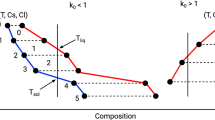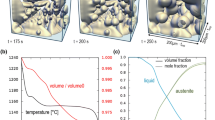Abstract
A model is developed to compute the capillary pressure for the migration of the liquid phase out or into a uniform solid–liquid–vapor system. The capillary pressure is defined as the reduction of the overall interface energy per volume increment of the transferred fluid phase. The model takes into account the particle size of the solid particle aggregate, the packing configuration (coordination number, porosity), the volume fractions of the different phases, and the values of the interface energies in the system. The model is used for analyzing the stability of the composition profile during processing of W-Cu functionally graded materials combining a composition gradient with a particle size gradient. The migration pressure is computed with the model in two stages: (1) just after the melting of copper, i.e., when sintering and shape accommodation of the W particle aggregate can still be neglected and (2) at high temperature, when the system is close to full density with equilibrium particle shape. The model predicts well the different stages of liquid-phase migration observed experimentally.









Similar content being viewed by others
References
A. Mortensen: in Comprehensive Composite Materials, A. Kelly, C. Zweben eds., Pergamon, Oxford, 2000, pp. 521–54.
Raharijaona J.-J., Missiaen J.-M. and Mitteau R., Ceram. Trans. 209, 321–31 (2010).
Lappalainen K., Manninen M., Alopaeus V., Aittamaa J. and Dodds J., Transp. Porous Media 77 (1), 17–40 (2009).
Bisson A., Rigacci A., Lecomte D., Rodier E. and Achard P., Drying Technology 21 (4), 593–628 (2003).
Colin C., Guipont V. and Delannay F., Metall. Trans. A 38, 150–58 (2006).
Lisovsky A.F., Int. J. Heat Mass Transf. 33 (8), 1599–603 (1990).
Dodds J.A. and Srivastava P., Part Part Syst Charact 23 (1), 29–39 (2006).
Park H.H., Cho S.J. and Yoon D.N., Metall. Trans. 15A, 1075–80 (1984).
Park H.H., Kang S.J.L., Yoon D.N., Metall. Trans. 17A, 325–30 (1986).
Delannay F., Pardoen D. and Colin C., Acta Mater. 53(6), 1655–64 (2005).
De Jonghe L.C. and Rahaman M.N., Acta Metall. 36 (1), 223–29 (1988).
Wakai F., Shinoda Y. and Akatsu T., Acta Mater. 52 (19), 5621–31 (2004).
Delannay F. and Missiaen J.-M., Acta Mater. 57 (2), 420–31 (2009).
Heady R.B. and Cahn J.W., Metall. Trans. 1A, 185-9 (1970).
Huppmann W.J. and Riegger H., Acta Metall. Mater. 23, 965–71 (1975).
Z.S. Nikolic, F. Wakai, Math. Comput. Modell. 55, 1251–62 (2012).
J.L. Johnson, R.M. German: in Proceedings of 16th Plansee Seminar 2, 116–129, G. Kneringer, R. Rödhammer, H. Wildner eds., Reutte, Plansee (2005).
Delannay F., Philosophical Magazine 85 (31), 3719–33 (2005).
Delannay F. and Colin C., Mater. Sci. Eng. A 495 (1–2), 236–43 (2008).
F. Delannay, Surf. Sci. 2016, 648, 262–70.
Svoboda J., Riedel H., Gaebel R., Acta Mater 44, 3215 (1996).
Ozer O., Missiaen J-M., Lay S., Mitteau R., Mater. Sci. Eng. A 460–461, 525–31 (2007).
Delannay F., Missiaen J.M., Acta Mater. 106, 22––31 (2016).
Johnson J., Brezovsky J., German R., Metall. Mater. Trans. 36A, 1557–65 (2005).
Raharijaona J-J., Missiaen J-M., Bouvard D., Metall. Mater. Trans. 42A, 2411–19 (2011).
Johnson J., Brezovsky J., German R., Metall. Mater. Trans. 36A, 2807–14 (2005).
Hodkin E.N., Nicholas M.G. and Poole D.M., J. Less-Common Met. 20, 93–103 (1970).
Keene B.J., Intern. Mater. Rev. 38 (4), 157–92 (1993).
H. Riedel, H. Zipse and J. Svoboda, Acta Metall. Mater. 42, 445–52 (1994).
C.H. Delaunay: J. Math. Pures et Appl., 1841, pp. 309–14.
Acknowledgments
This work was carried out with the support of the EFDA (European Fusion Development Agreement) and the European Union under the Association EURATOM/CEA entity. The authors also wish to thank the Eurotungstene company (Eramet group) for material supply and technical support.
Author information
Authors and Affiliations
Corresponding author
Additional information
Manuscript submitted July 31, 2015.
Appendix: Geometric Calculations
Appendix: Geometric Calculations
As shown in Figure 10, let us consider an orthogonal system of axes for which the origin is at the center of the cone basis, with coordinate axis X parallel to the basis, and Y pointing to the cone apex. The half-angle at the cone apex β simply derives from the average coordination number n C of the particles:
Plane section through the cone axis of Fig. 1 showing the profile of the solid particle surface and of the liquid–vapor surface during the pendular stage
The volume of the cone is given by the expression:
The curves denoted Y S(X) and Y L(X) are, respectively, the profiles of the solid/porosity interface and of the liquid/vapor interface intersected by plane (X, Y). The curve Y S(X) will be considered as divided into two parts: the part Y SL(X) expanding from the cone basis to the solid/liquid/vapor triple line represents the trace of solid/liquid interface whereas the part Y SV(X) expanding from the solid/liquid/vapor triple line to the lateral surface of the cone represents the trace of the solid/vapor interface. The angle β t < β locates the position of the triple line in the plane section, which is fixed for a given set of input parameters. β t tends to β as the liquid volume fraction reaches a critical value where the liquid menisci between adjacent particle contacts merge. This point will be addressed at the end of this appendix. At each point along the Y S(X) or Y L(X) curve, the radius of curvature is one of the two principal radii of curvature of the interface. This radius, which will be denoted R in plane, is defined positive when the center of curvature is on the solid side of the interface for Y S(X) or on the liquid side of the interface for Y L(X) and negative otherwise. For example, in the case presented in Figure 10, R in plane is positive for Y S(X) and negative for Y L(X). As interfaces are generated by the revolution of the corresponding Y(X) curve around the cone axis, the second principal radius of curvature, denoted R out of plane, is always positive.
The porosity volume fraction u and the different interface areas A SV, A SL, and A LV per grain are univocally determined by curves Y S(X) and Y L(X). For this purpose, it is convenient to convert X and Y(X) into nondimensional variables:
The ranges for x and y(x) are thus 0 ≤ x ≤ tanβ and 0 ≤ y(x) ≤ 1. The coordinates of the three points at the extremities of curves Y SL (x) and Y SV (x) are denoted (x Smin, 0), (x Lmax, y Lmax), and (x Smax, y Smax). In Figure 10, the surface representing porosity is divided in two parts, denoted S 1 and S 2. The volume of porosity is the volume created by the revolution of these surfaces around the cone axis. The corresponding two volumes, denoted V 1 and V 2, respectively, are expressed as
and
The porosity volume fraction is thus
The liquid volume can be calculated in the same way, with distinction between situations where the meniscus is concave or convex. If (β t + θ) < π/2 (concave menisci), then
whereas if (β t + θ) > π/2 (convex menisci), then
and the liquid volume fraction in the condensed mixture
is deduced.
The solid/liquid, solid/vapor, and liquid/vapor interface areas are created by a revolution of the curves Y SL(X), Y SV(X), and Y LV(X). respectively, around the cone axis. Denoting Hds an increment of length along the curve, the interface area per grain A SL, A SV, and A LV is written as
Finally, as Hx Smin is the radius of the circle circumscribing the solid/solid interface, the solid/solid interface area A SS per grain is simply
The family of axisymmetric surfaces with uniform curvature is called the Delaunay surfaces, and the curves generating these surfaces are called the Delaunay roulettes.[30] Although the problem can be solved exactly, it is tempting to approximate the curves Y S(X) and Y L(X) by two arcs of circle. The total curvature 1/R tot is then not uniform because the out of plane curvature 1/R out of plane varies along the curve. Nevertheless, it has been shown that this approximation does not bring about a large overestimation of the capillary energy in the case of a solid–liquid system.[18]
Equation of the surface profiles and boundary conditions for the calculations of the different volumes and areas must then be obtained. Let us denote R S = r S H and R L = r L H the radii of the arcs of circle representing the profiles of the solid/porosity and liquid/vapor interface, respectively. r S and r L are taken negative when the center of curvature of the profile is directed toward the exterior of the corresponding phase. By symmetry, the solid/porosity interface meets at 90 deg the lateral surfaces of the cone. It follows that the coordinates (x S0, y S0) of the in-plane center of curvature of this interface are
and
The function y S(x) then is written as
In the same way, the liquid/vapor interface meets at 90 deg the grain boundary plane, and the liquid content is parameterized either by the angle β t or by the coordinate x Lmax locating the solid/liquid/vapor triple line in the plane section (see Figure 10):
It follows that the coordinates (x L0, y L0) of the in-plane center of curvature of this interface are
and
The function y L(x) is then written as
and the coordinates of the limits of the corresponding profile are given by
Moreover, r S and r L are related by
At the limit of the pendular stage, when β t = β, a critical situation where adjacent liquid menisci merge is encountered. The in-plane center of curvature of the liquid–vapor interface is then transferred to the intersection between the cone and the boundary plane. This leads to a discontinuity in the position of the center and in the radius of curvature:
The porosity volume fraction u and the interface areas A SL, A SV, A LV, and A SS per grain are obtained by numerical calculations from relations [14] and [19]. The interface energy F per grain is deduced from Eq. [2].
Rights and permissions
About this article
Cite this article
Missiaen, JM., Raharijaona, JJ. & Delannay, F. Modeling the Capillary Pressure for the Migration of the Liquid Phase in Granular Solid–Liquid–Vapor Systems: Application to the Control of the Composition Profile in W-Cu FGM Materials. Metall Mater Trans A 47, 5569–5579 (2016). https://doi.org/10.1007/s11661-016-3702-5
Published:
Issue Date:
DOI: https://doi.org/10.1007/s11661-016-3702-5





